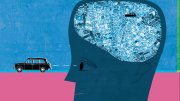Whether a train’s whistle or a cell-phone’s ring, sound is a fundamentally physical phenomenon, grounded in the vibrations of material objects. In a Monday evening lecture, “Hearing Through the Body”—part of the 2013-2014 Sawyer Seminar series “Hearing Modernity”—music scholars gathered to discuss the physicality of sound through two seemingly different examples: electronic dance music and cochlear implants for the deaf and hard-of-hearing. “The body is not only the site of listening,” the program description read, “it mediates, facilitates, and delimits the very possibility of hearing.”
In her presentation, “Earless Hearing,” Mara Mills, Ph.D. ’08, an assistant professor of media, culture, and communication at New York University, suggested that studies of deafness influenced the early development of the telephone. Alexander Graham Bell, for instance, is well known for working with deaf students, and Mills showed an excerpt from Bell’s notebooks in which he drew sound as wave-like signals to teach a deaf student how to manipulate the tone and volume of her voice. Describing research in her forthcoming book, On the Phone: Deafness and Communication Engineering, she explained, “AT&T researchers indeed continued to work with deaf and hard-of-hearing students and activist groups as they theorized the speech signal, and as they came up with ways to modulate and, later, to process those signals.”
Communications technology contributed, in turn, to the invention of new technologies for measuring hearing and amplifying sound, Mills continued. The key insight of the telephone—that sound waves can be converted into electrical signals, and vice versa—was carried over to medicine and physiology. Mills described a 1929 “cat telephone” constructed by Princeton researchers Ernest Wever and Charles Bray, who removed the skull and most of the brain of a live cat and connected its auditory nerve to an electrode. When one researcher spoke in the cat’s ear, the sound was seemingly converted, among the cat’s neurons, into an electrical signal that was transmitted through the electrode and a connecting wire to a telephone in a separate room. The cat acted as the telephone’s transmitting end. Although certain aspects of the Wever-Bray experiment were later disproven, Mills believes that the work inspired research on the cochlear implant, which converts sound into electrical signals that stimulate the auditory nerve to create a sense of hearing in deaf individuals.
A second exploration of sound in the body came from Mark J. Butler, associate professor of music theory and cognition at Northwestern University. Butler studies electronic dance music, a genre, he explained, in which strong, percussive beats are both heard by the ear and felt through the body. He described insights from his fieldwork studying disc jockeys and laptop performers, their digital counterparts, in Berlin, focusing on their use of repetition.
“It is necessary to stop equating repetition with stasis, and to tease apart notions of activity from those of change,” he said. He emphasized the “groove,” a repeated sequence that forms the rhythmic foundation of a piece of electronic dance music. A groove itself is also a material object, he pointed out, as described in his book Playing with Something That Runs: Technology, Improvisation, and Composition in DJ and Laptop Performance, to be published this summer. On a vinyl record, a “locked groove” is a circular engraving that repeats indefinitely, in contrast to a typical groove’s inward spiral. When the needle is dropped on a locked groove, the disc jockey has no way of knowing where in the rhythm the sequence will begin—he or she must find a downbeat and entrain to it to synchronize the new groove within the piece. Such circular repetition is essential to the genre, Butler argued. “In electronic dance music, groove dynamics and cyclical designs are continually interacting with more long-range, linear processes.”
The focus on sound’s physical nature continues with the series’ next lecture, “Sounds and the Brain,” to be held on Tuesday, March 11, in Holden Chapel. Grammy-nominated pianist-composer and 2013 MacArthur Fellow Vijay Iyer, Rosenblatt professor of the arts, will speak alongside Aniruddh Patel, associate professor of psychology at Tufts University, on the cognitive science of music. “Everybody is trying to come to terms with sound in their own way,” said Peabody professor of music Alexander Rehding, who organized the series with support from the Andrew W. Mellon Foundation. “It really feels like there is a buzz in the air.”
Seminar audio, papers from the speakers, and details about future events are available at the project’s website.









